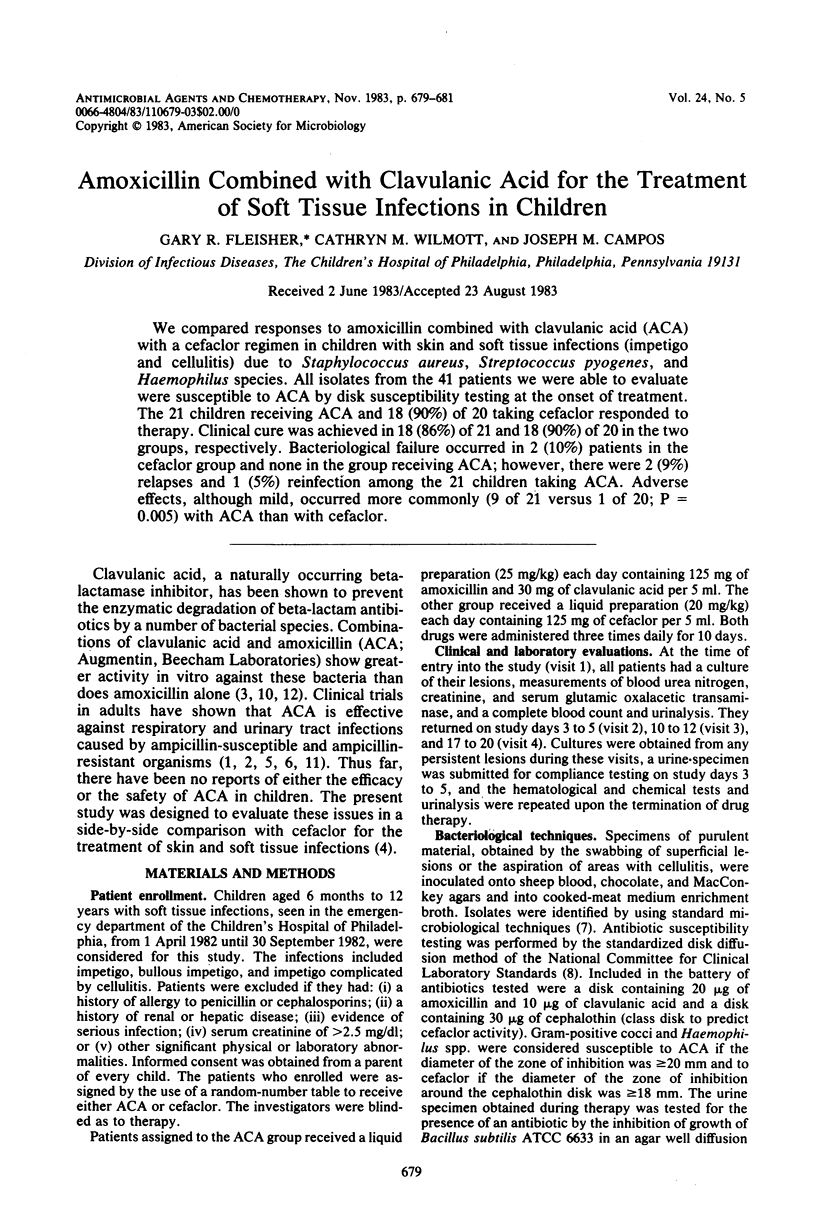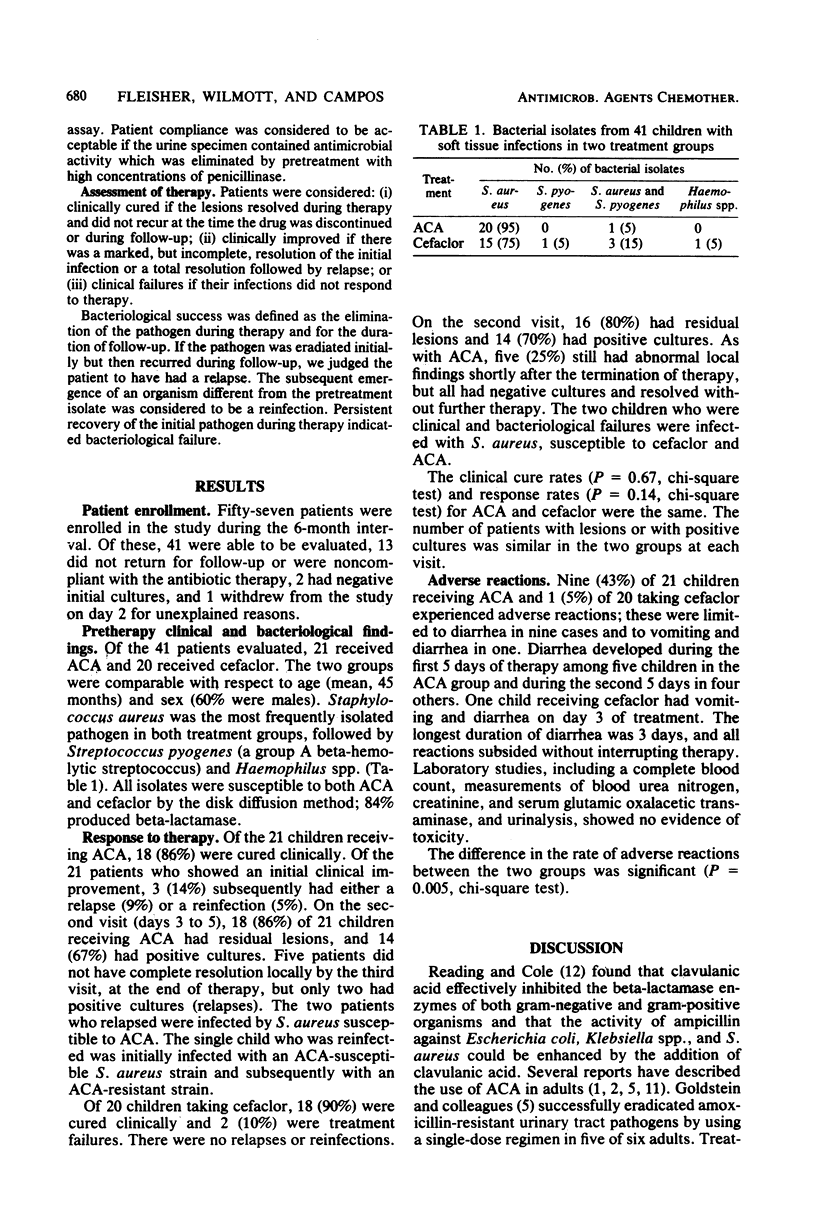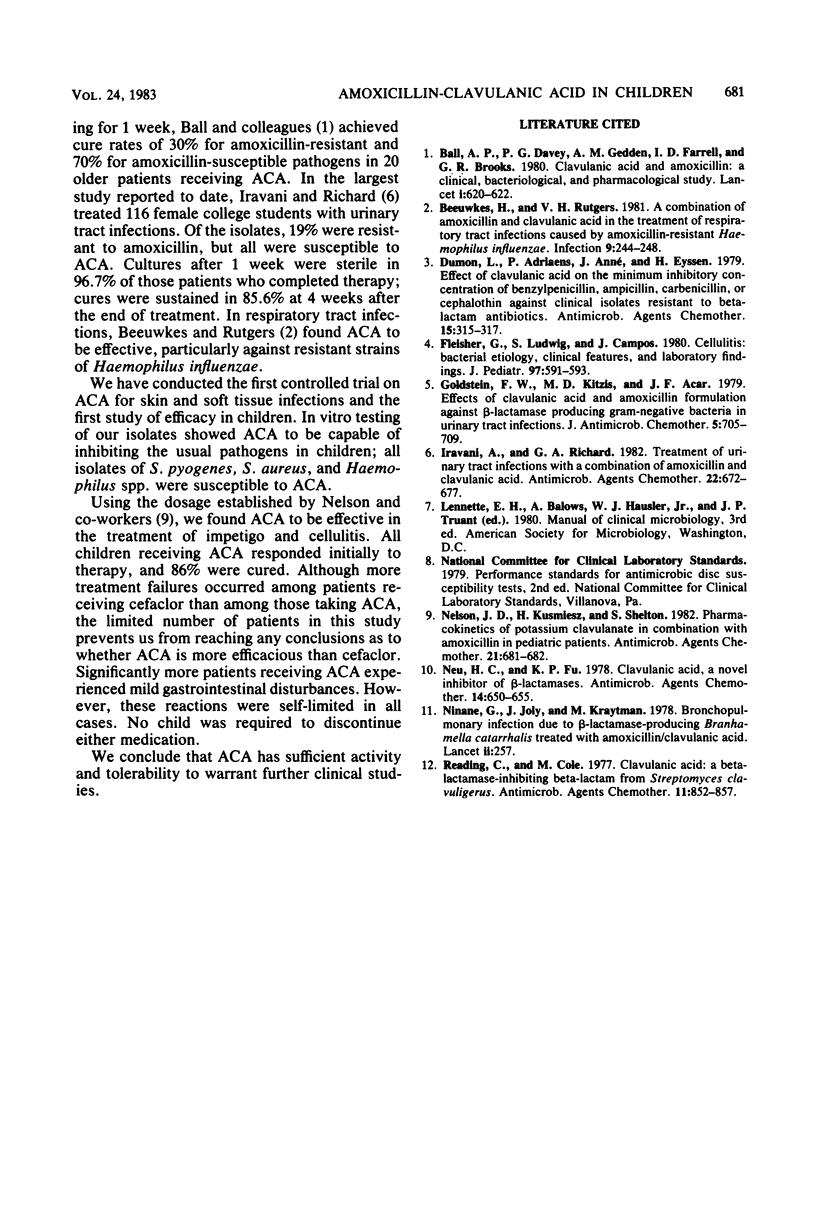Abstract
We compared responses to amoxicillin combined with clavulanic acid (ACA) with a cefaclor regimen in children with skin and soft tissue infections (impetigo and cellulitis) due to Staphylococcus aureus, Streptococcus pyogenes, and Haemophilus species. All isolates from the 41 patients we were able to evaluate were susceptible to ACA by disk susceptibility testing at the onset of treatment. The 21 children receiving ACA and 18 (90%) of 20 taking cefaclor responded to therapy. Clinical cure was achieved in 18 (86%) of 21 and 18 (90%) of 20 in the two groups, respectively. Bacteriological failure occurred in 2 (10%) patients in the cefaclor group and none in the group receiving ACA; however, there were 2 (9%) relapses and 1 (5%) reinfection among the 21 children taking ACA. Adverse effects, although mild, occurred more commonly (9 of 21 versus 1 of 20; P = 0.005) with ACA than with cefaclor.
Full text
PDF


Selected References
These references are in PubMed. This may not be the complete list of references from this article.
- Ball A. P., Geddes A. M., Davey P. G., Farrell I. D., Brookes G. R. Clavulanic acid and amoxycillin: a clinical, bacteriological, and pharmacological study. Lancet. 1980 Mar 22;1(8169):620–623. doi: 10.1016/s0140-6736(80)91118-6. [DOI] [PubMed] [Google Scholar]
- Beeuwkes H., Rutgers V. H. A combination of amoxicillin and clavulanic acid in the treatment of respiratory tract infections caused by amoxicillin-resistant haemophilus influenzae. Infection. 1981;9(5):244–248. doi: 10.1007/BF01640725. [DOI] [PubMed] [Google Scholar]
- Dumon L., Adriaens P., Anné J., Eyssen H. Effect of clavulanic acid on the minimum inhibitory concentration of benzylpenicillin, ampicillin, carbenicillin, or cephalothin against clinical isolates resistant to beta-lactam antibiotics. Antimicrob Agents Chemother. 1979 Feb;15(2):315–317. doi: 10.1128/aac.15.2.315. [DOI] [PMC free article] [PubMed] [Google Scholar]
- Fleisher G., Ludwig S., Campos J. Cellulitis: bacterial etiology, clinical features, and laboratory findings. J Pediatr. 1980 Oct;97(4):591–593. doi: 10.1016/s0022-3476(80)80014-x. [DOI] [PubMed] [Google Scholar]
- Goldstein F. W., Kitzis M. D., Acar J. F. Effect of clavulanic acid and amoxycillin formulation against beta-lactamase producing Gram-negative bacteria in urinary tract infections. J Antimicrob Chemother. 1979 Nov;5(6):705–709. doi: 10.1093/jac/5.6.705. [DOI] [PubMed] [Google Scholar]
- Iravani A., Richard G. A. Treatment of urinary tract infections with a combination of amoxicillin and clavulanic acid. Antimicrob Agents Chemother. 1982 Oct;22(4):672–677. doi: 10.1128/aac.22.4.672. [DOI] [PMC free article] [PubMed] [Google Scholar]
- Nelson J. D., Kusmiesz H., Shelton S. Pharmacokinetics of potassium clavulanate in combination with amoxicillin in pediatric patients. Antimicrob Agents Chemother. 1982 Apr;21(4):681–682. doi: 10.1128/aac.21.4.681. [DOI] [PMC free article] [PubMed] [Google Scholar]
- Neu H. C., Fu K. P. Clavulanic acid, a novel inhibitor of beta-lactamases. Antimicrob Agents Chemother. 1978 Nov;14(5):650–655. doi: 10.1128/aac.14.5.650. [DOI] [PMC free article] [PubMed] [Google Scholar]
- Ninane G., Joly J., Kraytman M., Piot P. Bronchopulmonary infection due to beta-lactamase-producing Branhamella catarrhalis treated with amoxycillin/clavulanic-acid. Lancet. 1978 Jul 29;2(8083):257–257. doi: 10.1016/s0140-6736(78)91763-4. [DOI] [PubMed] [Google Scholar]
- Reading C., Cole M. Clavulanic acid: a beta-lactamase-inhiting beta-lactam from Streptomyces clavuligerus. Antimicrob Agents Chemother. 1977 May;11(5):852–857. doi: 10.1128/aac.11.5.852. [DOI] [PMC free article] [PubMed] [Google Scholar]


